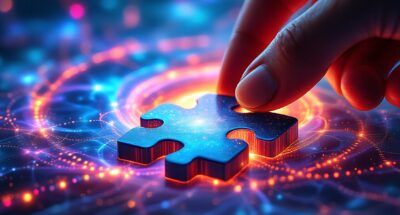Quiz: Uses of AI
1. AI still lags behind human performance in certain areas. But at which of the following tasks does it outperform us?
a) reading comprehension;
b) image recognition;
c) language understanding.
2.What are the main benefits of digital twins (not digital avatars)?
3. Should you use GenAI-based tools like ChatGPT to analyze data?
(Answers at foot of page)
Ways to collaborate for a sustainable future
Optimize data quality through collaboration
By leveraging big data and AI, industrial organizations can create a more integrated approach to energy management, optimizing resource use and reducing emissions. This can be done by:
- Establishing collaborative platforms, where companies can exchange information on energy consumption, production processes, and supply chain logistics.
- Developing cross-industry partnerships to drive innovation in energy solutions.
- Using a ‘systems of systems’ approach to transform isolated data points into actionable insights, leading to more sustainable practices.
Take collective action to benefit employees and employers
As AI becomes more central to the success of industrial business, the value of contextual data will rise. Companies must explore not only whether (and how) employees should be compensated for the data they produce, but how this data can be organized and pooled for industry-wide insights. One way to organize is data collectives, a model that allows individuals to pool their data, gaining collective bargaining power with the companies that rely on analyzing that data. The benefit is not only to employees: companies benefit from regularly updated, high-quality, and relevant data.
Build data literacy
To realize this mutual value, organizations need to raise the overall data literacy of leadership and workers to collectively derive the best insights out of AI. Data literacy enables workers to understand tech systems, helping them to determine which tasks they should delegate, and which they should not. This reimagines the contribution of employees to their organization. So far, employees have contributed with their time; in the age of AI-enabled or AI-dependent workplaces, their biggest contribution could be their data.
Quiz answers
1. All of them. According to Time magazine, while AI is yet to surpass humans significantly in tasks such as handwriting and speech recognition, it outperforms us in many other areas, including these.
2. Digital twins – virtual, real-time models of a physical object, system, or process – can improve decision-making, enhance operational performance, streamline procedures, and lower production costs. Gartner projects that more than 40% of large companies will use digital twins for operational excellence by 2027.
3. Yes and no. You can use GenAI-based tools to write and run the code to analyze data. But you need to be very careful when prompting the system, such that it uses the language function to write coding language that it runs on the data. You can learn more about this in chapter 6 of this book.





